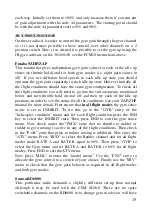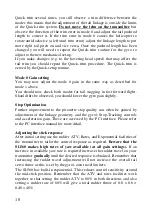
9
Mid stick trim
N
With the rudder stick and trim centred make sure that servo arm is at
right angles to tail push rod.
N
Now adjust push rod length until the pitch of the tail blades is about 8
degrees with the rudder stick centred. This will correspond
approximately to the pitch of the tail in the hover and ensures that the
servo will be close to its mid position in the hover. The diagram below
will help you judge 8 degrees of pitch.
8
8
0
0
Servo arm length
N
Watch the tail rotor linkage while moving the rudder stick slowly fully
left and fully right. If the linkage does not approach either extreme of
the pitch linkage travel then increase the servo arm length. Conversely,
if the linkage binds at one extreme or the other then slightly reduce the
servo arm length. Re-check the mid-stick pitch set-up and repeat this
test. You are looking to achieve a servo arm length that gives full pitch
linkage movement but avoids the linkage binding or the servo stalling.
Many helicopters have pitch systems that do not give equal throw
about the hover pitch value. The SL560 has independent servo throw
adjustments for left and right which will accommodate this and fine
tuning of the servo throw is done later (in the Quick-setup routine).
Rudder control sense
N
Now we must establish that the sense of the transmitter rudder control
is correct (i.e. that the application of a right rudder command causes a
change in tail pitch that will rotate the model to the right).
Failure to
do this will cause an uncontrollable pirouette on take-off.
Beginners who are in any doubt on this aspect of the set-up should
seek advice.
To work out which way the tail rotor will go just
remember the leading edge (front) of the tail blades will point in the
direction that the tail rotor will go, so for a left stick command you
want the tail blades to point to the right (tail swings to the right and the
nose goes left). It is vital for this test that you have the tail blades fitted
the right way around!

























